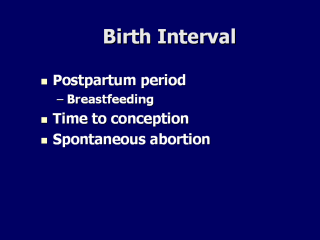| front |1 |2 |3 |4 |5 |6 |7 |8 |9 |10 |11 |12 |13 |14 |15 |16 |17 |18 |19 |20 |21 |22 |23 |24 | 25|26 |27 |28 |29 |30 |31 |32 |33 |34 |35 |36 |37 |38 |39 |40 |review |
 |
The pace of childbearing is also influenced by
a number of biologic factors within the reproductive period as well. First, the postpartum period, which occurs after birth until ovulation resumes, will clearly impact the birth interval. The longer the postpartum period, the longer the birth intervals will be. One behavior which can lengthen this period is breastfeeding. Breastfeeding exerts this effect through a maternal response to suckling that suppresses the secretion of gonadotrphins. Whereas women who do not breastfeed usually menstruate for the first time about 2 months after birth, frequent, intense breastfeeding can postpone the average time of ovulation to over 20 months. Women who supplement breastfeeding with cereal or foods will experience a postpartum period somewhere in between those two estimates. In populations where no family planning is practiced, breastfeeding has the greatest impact on fertility rates and birth intervals. A second major factor influencing the birth interval is time to conception. Time to conception depends on the monthly probability of conception in the absence of birth control and varies among populations, by age, and according to the pattern of intercourse. Time to conception is longer among subfertile couples and for some women with a history of PID. Lastly, the occurrence of spontaneous abortions (lost of conceptus prior to 22 weeks), which occur in about 10% of recognized pregnancies and up to 20% or more of all pregnancies, including those which are unrecognized, increases the birth interval. |